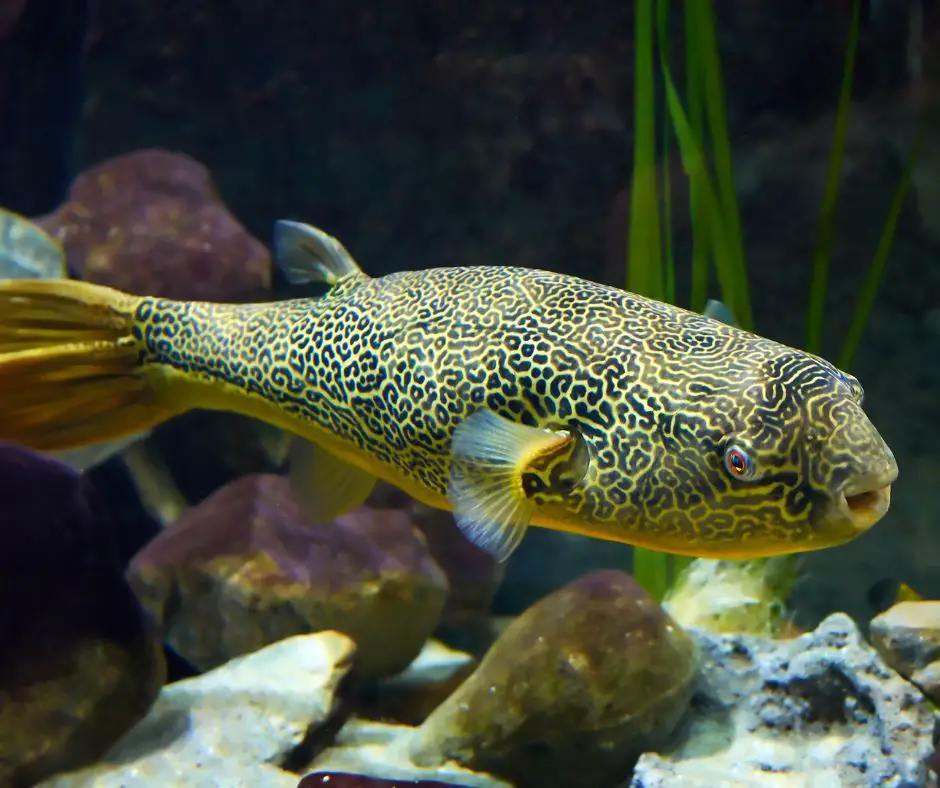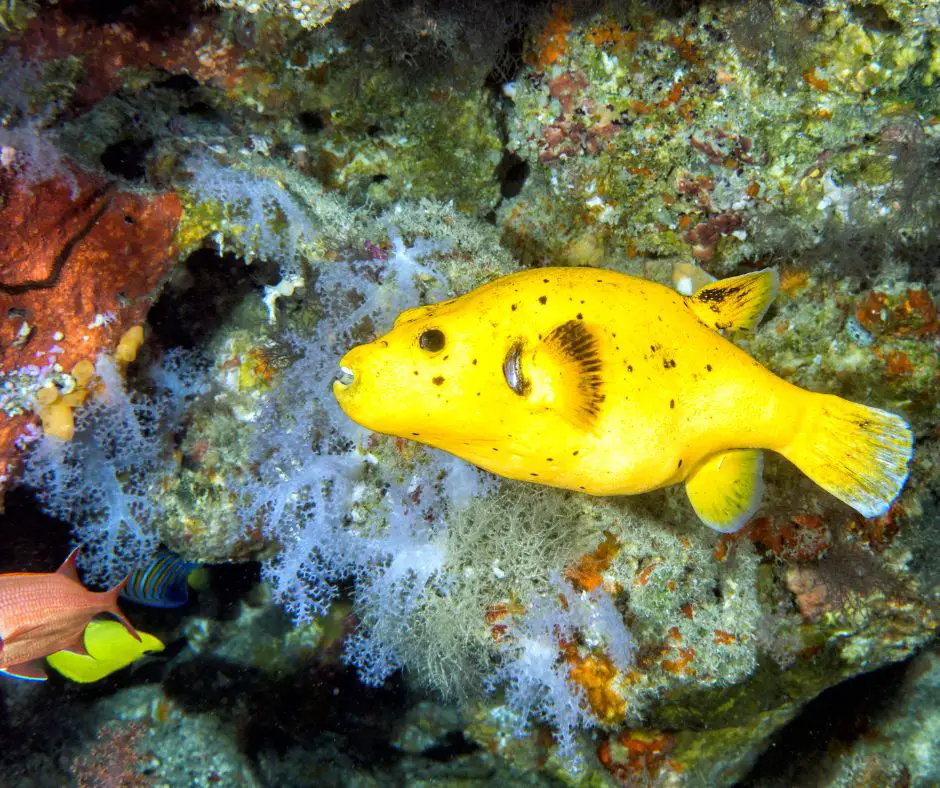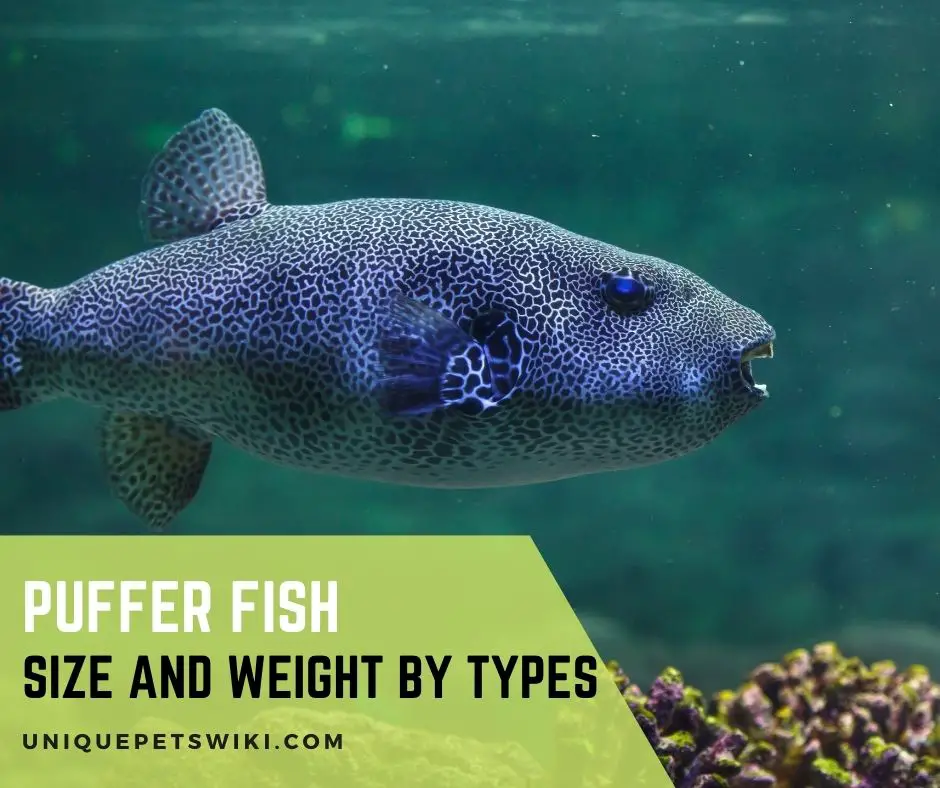Pufferfish come in different varieties, including dwarf, medium-sized, and largest species. Knowing pufferfish size and weight by type will help you know each species’ requirements and how best to care for them.
For instance, if you want to buy an ideal tank for your puffer pet, you must consider the fish’s size and full potential length. Large species won’t thrive on small tanks.
Likewise, getting an extremely big tank for a dwarf puffer would be a waste of money. Further in the article, we’ll discuss pufferfish types, their sizes, the minimum tank size for each, and their costs.
Contents
What Is the Average Weight of a Pufferfish?
A fully grown puffer weighs roughly 30 pounds (13.6 kgs). Since different species of pufferfish exist, their final length varies too, ranging from 8-60cm (3-24 inches).
In particular, pufferfish can inflate their body under specific circumstances. They expand a lot, up to three times their original size. Eventually, the body deflates after several hours to its typical size.
The biggest species, e.g., Mbu pufferfish, have a massive size and heavyweight, while dwarf species grow to a small size and are lightweight.

Pufferfish Size and Weight by Types
Puffers’ different sizes can depend on many factors, but the pufferfish breed directly affects their size.
For example, dwarf or pygmy puffers are only 1-inch-long; however, freshwater giant pufferfish can grow even above 3 feet in length.
The table hereunder illustrates pufferfish breeds, average size, mini-tank size, and the approximate cost for each.
| Types of pufferfish | Size | Mini tank size | Cost |
| Dwarf Puffer Fish | 1.4 inches (3.6 cm), 1.58 pounds. | 7 gallons | $7 |
| Red-Eyed Puffer Fish | 3 inches (7. 62 cm), 3.3 pounds. | 15 gallons | $15 to $30. |
| Figure 8 Puffers | 3 inches (8 cm), 3.7 pounds. | 25 gallons | $10 to $50 |
| Valentini Puffer Fish | 4. 5 inches (11. 43 cm), 5 pounds. | 25 gallons | $20 to $30 |
| Arrowhead Puffer fish | 4. 5 inches (11. 5 cm), 5 pounds. | 25 gallons | $20 to $30 |
| South American Puffer Fish | 5 inches (12. 7cm), 5.5 pounds. | 30 gallons | $33 |
| Target Puffer Fish | 6 inches (15 cm), 6.6 pounds. | 35 gallons | $40 to $50 |
| Ocellated Puffer Fish | 6 inches (15 cm), 6.6 pounds. | 35 gallons | $18 to $32 |
| Green spotted puffer | 6 inches (15 cm), 6.6 pounds. | 35 gallons | $80 to $150 |
| Dragon Puffer size | 7 inches (17.8 cm), 7.7 pounds. | 55 gallons | $40 to $110 |
| Dog Face Puffer Fish | 12 inches (30.5 cm), 13.4 pounds. | 75 gallons | $35 to about $250 |
| Fahaka Puffer Fish | 18 inches (45. 72 cm), 19.8 pounds. | 100 gallons | $32 |
| Golden Puffer Price | 20 inches (50. 8 cm), 22 pounds. | 125 gallons | $300 to $800 |
| Mbu Puffer Fish | 24 inches (60. 96 cm), 30 pounds. | 500 gallons | $150 to $500 |
Note: Above weight, data is just the weight expectation for animals as specific body size. That’s not scientific information.
Smallest Puffer Fish Size
The dwarf pufferfish also goes with a few other names, including pygmy pufferfish, pea pufferfish, Malabar pufferfish, and dwarf pea puffer, which is the smallest puffer in the world.
The fish species grow to a final size of 1.4 inches (3.6cm) and averagely weigh 1.58 pounds. Dwarf pufferfish live in rivers, estuaries, and lakes in southwest India.
The water conditions vary between each water body, with water temperature ranging approximately 77℉ and a pH between 6.5-8.5.
Dwarf pufferfish have won the heart of many aquarists and fish keepers because of their small size, intelligent personality, and unique appearance.
Unfortunately, because of their popularity, most species are wild-caught, making dwarf puffers vulnerable and threatened.
Largest Puffer Fish Size
The Mbu pufferfish, also known as Mbuna pufferfish, giant freshwater pufferfish, or giant pufferfish, is the largest breed of pufferfish. They can grow to 24 inches, and some reach 26 inches.
These giant fishes live in lakes and rivers across Central Africa, including Lake Tanganyika. Their natural habitat consists of large areas of open water and a warm climate.
Because of their mighty size, giant puffers require a big tank and are the best pets for experienced fish keepers.
These puffer species are rare and uncommon in the fish-keeping community. They have tons of personality, are fun to observe, and are among the most sought-after pets.
Factors Affect Pufferfish Size and Weight
The size and weight of pufferfish differ vastly from species to species. How heavy or long a puffer will grow depends on several factors, ranging from genetics, tank size, diet, and disease.
A pufferfish meant to grow to 20+ inches long may become undersized because of poor husbandry care.
So then, how you keep your puffer pet can determine how long it will grow. Below is an in-depth discussion of factors affecting pufferfish size and weight.
Genetics
Different types of puffers have different sizes because of genetics. Inherited genes play a significant role in determining how long a pufferfish will be as an adult.
For instance, the dwarf species have genes for shortness, while giant puffers’ genetics allows them to grow longer and heavier.
Parents pass on traits to their offspring. And this means that the offspring cells acquire genetic information from their parents.
Tank Size
The pufferfish breed determines the tank’s size. Larger breeds require massive tanks, while a smaller breed is fine in a small tank.
The size of the tank impacts the size of a pufferfish. For example, large puffer varieties cannot grow fully in small tanks. Cramped aquariums subject pufferfish to prolonged stress because they live uncomfortably.
Small pufferfish varieties can live in 20-30 gallons tanks, but a large puffer requires a 100+ tank, depending on the species.
Diet
Proper diet and other factors, including the aquarium condition, promote good health, typical growth, and long lifespan in pufferfish. On the other hand, a bad diet and improper feeding schedule adversely affect puffers’ health.
Baby pufferfish grow so fast, and if they don’t get proper food to support their rapidly growing bodies, they’re at risk of low immunity and stunted growth.
The fish will not grow to attain their maximum size, and some die when still young.
Disease
Pufferfish are susceptible to internal parasites, especially tapeworms. The parasites reproduce and multiply when the fish is ill or under stress.
The effect of internal parasites in pufferfish includes anorexia, increased mortality, morbidity, and growth impairment.
If the parasites establish internally, baby pufferfish quickly lose appetite for food and exposes themselves to poor growth due to inadequate nutrients.

Overfeeding Puffer Fish or Skinny
Pufferfish have an incredible appetite; some don’t stop eating even after a decent meal.
Because they can eat constantly, it’s pretty easy to overfeed these fish. Because pufferfish come in different varieties, their sizes differ considerably.
Therefore, the thin or fat pufferfish must be based on the specific breed of the puffer. However, fat puffers are rare. If you notice a pufferfish gain weight, it could be puffy and not fat.
When pufferfish are puffy, they become almost three times bigger than their original size, and one can mistake them for being fat. Being skinny is more common in pufferfish. They feed constantly, but it rarely makes them fat.
Their tummy should never lose its rounded look. If a puffer has a flat belly and you keep feeding it and notice it doesn’t grow, the fish is emaciated.
And this is often associated with parasites, a bad diet, and an improper feeding schedule. You can seek help from your vet to know the problem and its possible solution.
FAQs
What is the average weight of a pufferfish?
Large varieties of pufferfish weigh approximately 20-30 pounds, and small varieties also differ greatly in weight, which can be 2-10 pounds, depending on species.
What is the heaviest pufferfish?
Mbu pufferfish is the heaviest and also the longest pufferfish worldwide. These fish grow to tremendous sizes, most weighing 30 pounds and others more.
What is the normal size of a pufferfish?
Puffers range in size, from 1-inch to 24-inches in length. Pufferfish obtain a different length when fully grown, depending on the species.
How big do figure 8 pufferfish get?
Figure 8 pufferfish are small in size, growing to fewer than three inches long, with an average weight of 3.7 pounds.
How big do Leopard puffers get?
The leopard puffers, also known as green spotted pufferfish grow up to 6-inches long at full maturity. Averagely, these fish weigh 6.6 pounds.
How big do Amazon puffers get?
Amazon pufferfish are typically smaller puffers that reach three inches long on average, with a maximum weight of 3.5-4 pounds.
Final Sentences
Pufferfish exist in different varieties, ranging from dwarf to giant species. Dwarf varieties are the pygmy pufferfish that grow to one inch long at full maturity.
Giant pufferfish grow to an enormous size, reaching up to 24 inches or more in length.
Pufferfish require to live in a proper environment to grow successfully. It’s a commitment that aquarists or fish keepers need to make to ensure their pets live comfortably and eat healthy to grow properly.
We recommend that larger puffers like Mbu pufferfish be raised by experienced aquarist, but smaller breeds like dwarf puffers are good for beginners. The larger the fish, the bigger the tank, and the more care needed.
